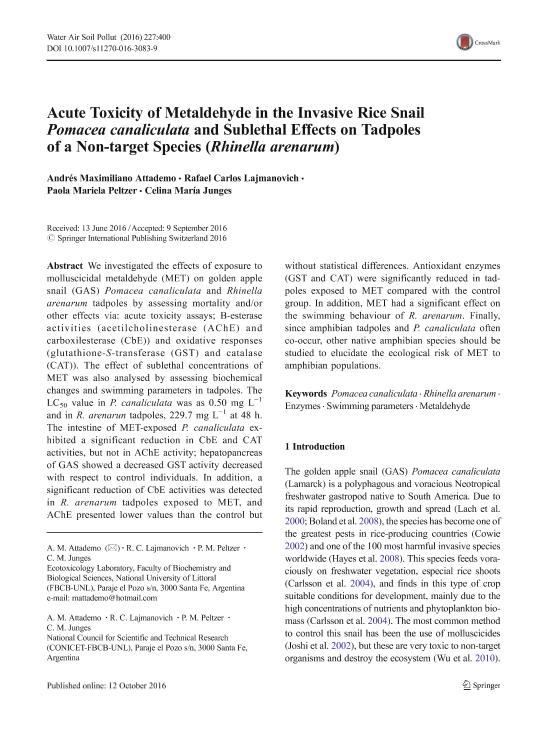Artículo
Acute Toxicity of Metaldehyde in the Invasive Rice Snail Pomacea canaliculata and Sublethal Effects on Tadpoles of a Non-target Species (Rhinella arenarum)
Fecha de publicación:
2016
Editorial:
Springer
Revista:
Water, Air and Soil Pollution
ISSN:
0049-6979
Idioma:
Inglés
Tipo de recurso:
Artículo publicado
Clasificación temática:
Resumen
We investigated the effects of exposure to molluscicidal metaldehyde(MET) on golden apple snail (GAS) Pomacea canaliculata and Rhinella arenarum tadpoles by assessing mortality and/or other effects via: acute toxicity assays; B-esterase activities (acetilcholinesterase (AChE) and Carboxilesterase (CbE)) and oxidative responses glutathione-S-transferase (GST) and catalase (CAT). The effect of sublethal concentrations ofMET was also analysed by assessing biochemical changes and swimming parameters in tadpoles. The LC50 value in P. canaliculata was as 0.50 mg L−1 and in R. arenarun tadpoles, 229.7 mg L−1 at 48 h. The intestine of MET-exposed P. canaliculata exhibited a significant reduction in CbE and CAT activities, but not in AChE activity; hepatopancreas of GAS showed a decreased GST activity decreased with respect to control individuals.In addition, a significant reduction of CbE activities was detected in R. arenarum tadpoles exposed to MET, and AChE presented lower values than the control but without statistical differences. Antioxidant enzymes(GST and CAT) were significantly reduced in tadpoles exposed to MET compared with the control group. In addition, MET had a significant effect on the swimming behaviour of R. arenarum. Finally,since amphibian tadpoles and P. canaliculata often co-occur, other native amphibian species should be studied to elucidate the ecological risk of MET toamphibian populations.
Archivos asociados
Licencia
Identificadores
Colecciones
Articulos(CCT - SANTA FE)
Articulos de CTRO.CIENTIFICO TECNOL.CONICET - SANTA FE
Articulos de CTRO.CIENTIFICO TECNOL.CONICET - SANTA FE
Citación
Attademo, Andres Maximiliano; Lajmanovich, Rafael Carlos; Peltzer, Paola; Junges, Celina Maria; Acute Toxicity of Metaldehyde in the Invasive Rice Snail Pomacea canaliculata and Sublethal Effects on Tadpoles of a Non-target Species (Rhinella arenarum); Springer; Water, Air and Soil Pollution; 2016
Compartir
Altmétricas




